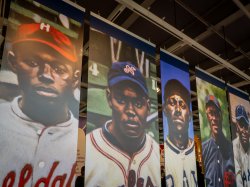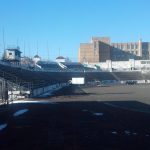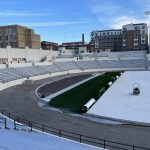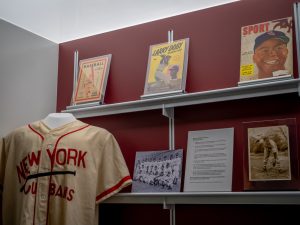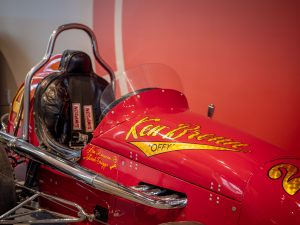ABOUT HINCHLIFFE STADIUM
Built in the Great Depression and perched above the majestic Great Falls of Paterson, NJ, Hinchliffe Stadium has a unique foothold in American culture and history.
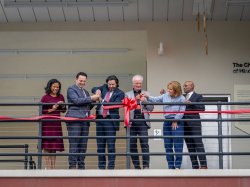
During its 1930s and ‘40s heyday, coinciding with the segregated Jim Crow era, Hinchliffe played host to significant Negro Leagues baseball. Crowds flocked to see some of the world’s greatest ballplayers – from Josh Gibson to Cool Papa Bell to Monte Irvin and Paterson’s own Larry Doby – many of them denied entry into Organized Baseball only because of their skin color.
The oval-shaped concrete stadium, designed in classic Art Deco style with a 10,000-seat capacity, also served as home for the New York Black Yankees and New York Cubans. But Hinchliffe was also a year-round venue of varied and notable events.
A source of immense civic pride in working-class Paterson, Hinchliffe was a popular gathering ground for semiprofessional football, amateur boxing matches, midget car racing, track and field meets and major musical entertainment.
It often drew overflow crowds for a storied Thanksgiving Day tradition – the cross-city high school football rivalry between Eastside and Central (now Kennedy).
Hinchliffe Stadium’s historic and social significance can never be denied. It is planted to Paterson, established in 1792 as America’s first planned industrial city. It is located within the Great Falls Historic District. And it’s unique for its longtime association with the city’s public school system.
REFURBISHING A FIELD OF DREAMS
Plagued by neglect and vandals, Hinchliffe Stadium lapsed into terrible disrepair. The grandstands were overrun with weeds and graffiti, the playing field was a wreck, the stadium’s glorious past a dim memory. It was condemned in the late 1990s.
But Hinchliffe was spared destruction in 2013 largely due to the efforts of a nonprofit organization, the Friends of Hinchliffe Stadium. The stadium was designated as a National Historic Landmark, one of the last remaining Negro League ballparks in the country.
It also became the nation’s only sporting venue in the National Park System – and is now part of the Paterson Great Falls National Historical Park.
Finally, after years of dilapidated ruin and political wrangling, long-dormant Hinchliffe Stadium started returning to life.
In 2021, work began on a multimillion-dollar renovation. Led by BAW Development and RPM Development Group, the ambitious project to rejuvenate the stadium also included a nearby senior housing development, child-care facility and parking garage.
And affixed to the refurbished Hinchliffe Stadium, work also began on a dynamic museum and learning center, honoring the history of the Negro Leagues and Larry Doby. The Charles J. Muth Museum of Hinchliffe Stadium, operated by Montclair State University, is scheduled to open in Fall 2023.
THE HOUSE THAT MUTH BUILT
Charles Muth grew up in Paterson, almost in the shadows of Hinchliffe Stadium. He drove a soft-drink truck as a young man, and graduated from Montclair State in 1977 with a bachelor’s degree in marketing and management. He also never forgot the emphasis his parents placed on the power of higher education to shape his life.
Throughout a successful career in the beverage and beef industries, Muth has remained true to his school. He has created numerous opportunities for Montclair State students to succeed through education and serves on the Feliciano School of Business advisory board.
In December 2022, he stepped to the plate in a major way. Muth made a $5 million donation to establish a museum and education center at Hinchliffe Stadium, which will be operated by Montclair State.
The Charles J. Muth Museum of Hinchliffe Stadium will focus on Hinchliffe’s lore, with a special focus on the proud yet shameful story of baseball history, ruled by the ignorance of Jim Crow – the Negro Leagues. To Muth, the legacy and leadership of players like Larry Doby, who also grew up in Paterson and along with Jackie Robinson broke baseball’s color barrier, must never be forgotten.
“When I left the city, I always felt the obligation to give back in a meaningful way,” Muth said. “And so I would like to see the money go toward education. I think the outreach program educating students in particular about the history of Paterson, about the history of Hinchliffe Stadium (would) really be the outcome that I would love to see.”
To learn more about the Charles J. Muth Museum of Hinchliffe Stadium, visit the official website here: montclair.edu/muth-museum-hinchliffe
